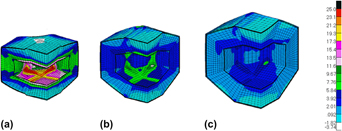Article contents
Insights on uniaxial compression of WS2 inorganic fullerenes: A finite element study
Published online by Cambridge University Press: 15 August 2011
Abstract

We report here a finite element simulation of the compression of inorganic WS2 hollow nanoparticles. The particle was modeled as a multilayered polyhedron to investigate the effect of the unique onion-like and highly faceted structure in the mechanical response. The simulation revealed the central role of the faceted structure of the WS2 nanoparticles in the mode of failure. The stress magnitude and distribution was shown to be size dependent, as predicted from previously published experimental results. Moreover, the simulation points to the influence of the layered structure on the energy release during compression loading via interlayer shear.
- Type
- Articles
- Information
- Journal of Materials Research , Volume 27 , Issue 1: Focus Issue: Instrumented Indentation , 14 January 2012 , pp. 161 - 166
- Copyright
- Copyright © Materials Research Society 2011
References
REFERENCES
- 3
- Cited by


